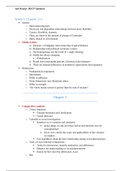Anh Hoang- MSCP Summary
Week 1: Chapter 1+2
System:
o Interconnecting parts
o Necessary and dependent relationships between parts (Stability)
o Variety, flexibility, dynamic
o There are limits to the amount of changes (Constraint)
o Open, related to environment
Media system:
a) Separate, overlapping, interconnecting of parts/elements
b) Relationship with political/ economic system
c) Not homogenous, not the result of 1 single ideology
d) Stable but always changing
Globalization
e) Result from meaningful patterns of historical development
f) There are internal differences in normative expectations and regulation
Dimensions:
o Fundamental components
o Interrelated
o Differ in influence
o Some dimensions may illuminate others
o Differ in strength
o “the whole media system is greater than the sum of its parts”
Chapter 1:
Comparative analysis:
o 2 basic functions:
Concept formation and clarification
Causal inference
o Valuable in social investigation:
Sensitizes us to variation and similarity:
notice things we did not notice before and therefore has not
conceptualized
forces us to clarify the scope and applicability of the concepts
we employ
Test hypothesis about the inter relationship among social phenomenon
o Aims of cross-national comparisons:
Seeks for distinctions, identify similarities and differences
Enhance our understanding of social phenomenon
Search for how and why differences occur
o But:
,Anh Hoang- MSCP Summary
Refrain from subjective judgement
Be aware of points of reference
Avoid cultural bias/ethnocentrism
“Four Theories of the Press” (Siebert, Peterson, Schramm)
o did not analyse the relation between media system and social system
o Look only at the “rationales or theories” in which media legitimated
themselves
o Normative Judge the world press system in terms of their distance from the
liberal ideal of a neutral “watchdog” free from state interference
H&M Comparative analysis
o Empirical understand why media systems developed in particular way
o Based on social context
Globalization
o Media systems are affected by globalization
o Globalization: “worldwide climate in which people, industries, government,
and countries across the world are being propelled into closer political,
economic and cultural unions”
o Drivers of globalization:
Main force: Economic: corporate profit making
o Drivers of globalization of media:
a) Communication Technologies
b) International travel
c) Global media conglomerates
d) Audience curiosity: changing consumption patterns
People more interested in foreign culture and media content
Consumerism
Globalization leads to:
o Diminishment of nation states powers
o Convergence of media system
o Homogenization of content
However: Role of nation state
o Media system continued to be shaped by national characteristics
o Media system remain to a significant degree national in organization and
orientation
o Nation-states still determine to a high degree how media industries and
markets are organized and what media services are provided and received
We need “a model of media globalization that recognizes the continuing role of the
national and conceptualizes the phenomenon in terms of a convergence of policy orientations,
market development and programming trends within countries”
, Anh Hoang- MSCP Summary
Chapter 2:
1. Development of Media Market
Media markets:
o “How is media produced, financed, consumed?”
o structure including ownership, concentration, market shares, audience
behaviour and media access, use, …
Reflected in the different rates of newspapers circulation
o Southern Europe: low circulation rates
Horizontal: inter-elite communication via newspapers
Newspapers is not historically a business enterprise
Subsidized by political actors
Larger gender differences (differences in literacy rates)
o Northern Europe/America: high circulation rates
Vertical: newspapers mediate between political elites and ordinary
citizens (to the mass)
Strong commercial media enterprises
Early development of mass-circulation (commercial) press
Language factors also divide media market into different segment
Newspapers markets vary in the balance of local, regional and national newspapers
o National newspapers tend to produce more politically differentiated press
Germany, France
o Super-regional: USA, Canada
Quality differences:
o Clear separation between a sensationalist mass press and “quality” papers
addressed to and elite leadership (Britain)
2. Political parallelism
Political parallelism: Media’s engagement and alliances with social/political groups
o Relationship of the media, journalists, and the political spheres including
political communication and political culture
Political orientation- party press parallelism
o Media content: the extent to which the different media reflect distinct political
orientations in their news and current affairs reporting
o Organization connection: each news organization is aligned with particular
party
o Political activism: the tendency for media personnel to be active in political
life
o Partisanship of media audiences: audiences consume media products affiliated
with their political orientation






